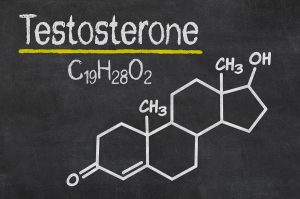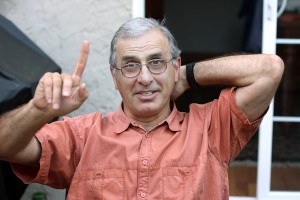Dr. Gary Huber recently gave a lecture on what’s new about testosterone. He presented his talk at the 24th Annual World Congress on Anti-Aging Medicine (Dec. 9-11, 2016) in Las Vegas that I attended. It was entitled “Evolution of Testosterone – Dispelling Myths & Charting a Future”.
History of testosterone
There are some notable historic landmarks with respect to the discovery of testosterone.
1869: Dr. Charles Brown-Sequard suggested that the “feebleness of older men” was due to a lack of testosterone. He injected himself with testicular extracts from dogs and guinea pigs.
1912: The Danish physician Dr. Thorkild Rovsing transplanted the testicles of a young soldier killed in battle into an old man with gangrene. The gangrenous wound healed completely.
1918: Dr. Leo Stanley sampled fresh testicles from executed prisoners at the San Quentin Prison and transplanted them to prison inmates. Some regained their sexual potency.
1930’s: Professor Adolf Butenandt collected 25,000 liters of urine from willing policemen. He was able to isolate a breakdown product of testosterone, androsterone. Eventually he isolated both progesterone and testosterone. He received the Nobel prize for his work with sex hormones in 1939.
Historical detours and misguided opinions about testosterone
1935: Because natural hormones cannot be patented, Big Pharma came up with the idea of modifying testosterone by adding a methyl group at the 17-alpha position of testosterone. This new substance, 17 alpha-methyltestosterone, was a new compound. The FDA could patent it. Men liked it, because they could swallow this testosterone derivative as a pill. However, the liver changed 17 alpha-methyl-testosterone into 17 alpha-methyl-estradiol, a strong estrogenic compound. The body could not metabolize this testosterone compound too well. Shortly after introduction into patients it became evident that 17 alpha-methyl-testosterone caused liver cancers. This “testosterone equivalent” was on the market for 50 years before the FDA outlawed it because it caused liver cancer. It also caused suspicion among physicians about any testosterone replacement, even the bioidentical hormones that are safe.
Prostate cancer myths
Prostate cancer myth
Conventional medicine teaches (and I have believed this for many years) that testosterone would be the cause for prostate cancer. This was based on old observations by Dr. Huggins, a Canadian born surgeon who practiced in Chicago, that orchiectomy improved the survival of advanced prostate cancer patients a bit. Dr. Lee pointed out that Dr. Huggins neglected to realize that testicles make both testosterone and small amounts of estrogen. The belief that testosterone production was the culprit of prostate cancer led to the practice of physicians to do orchiectomies. This inadvertently removed the real cause of prostate cancer, an estrogen surplus. This improved the survival of these patients somewhat. Nowadays we have more sophisticated testing methods.
Estrogen causes prostate cancer, testosterone does not
Dr. Abraham Morgentaler (Ref. 1) has compiled a lot of evidence about the importance of testosterone in men. He proved, based on a lot of more modern references, that it is not testosterone that is the cause of prostate cancer. We know now that estrogen dominance is responsible for prostate cancer and that this develops as stated above because of the low testosterone and low progesterone during the male menopause (also called “andropause”).
It is important, when testosterone deficiency is present in an aging man, to replace the missing testosterone with bioidentical testosterone.
Some physicians still practice the old method of hormone depletion therapy in advanced prostate cancer cases. But Dr. Morgentaler and other researchers have shown that it is wrong to do hormone depletion therapy or orchiectomies.
10% absorption rule myth
For years there has been a persistent myth that the skin would only absorb 10% of testosterone. There was never any proof of this and newer studies showed that indeed the skin absorbs about 90% of testosterone.
Misleading science created myths
Unfortunately three key medical journals, JAMA, NEJM and PLOS ONE have published misleading studies. The content did not discuss physiology, mechanism of actions, appropriate dosing or true science. But they concluded that testosterone therapy was causing heart attacks and strokes. There was an outcry about this particular study in the medical community. Unfortunately there were more similar false “studies”. The problem with these was that the controls were wrong or they compared unequal groups that were not comparable. It is reminiscent of previous effort of the tobacco industry wanting to cover up that cigarette smoke causes lung cancer.
Testosterone replacement treats the cause of the deficiency
Here we have the problem that testosterone cures so many conditions for which the Pharma industry has many patented medicines that control the symptoms. But testosterone can actually treat the cause of the illness, testosterone deficiency, which leads to a cure of many other symptoms.
For a long time confusion plagued the older physician generation. But younger physicians are replacing the older generation and they treat testosterone deficiency with bioidentical testosterone in the proper dose.
Clinical observations about a lack of testosterone
There is evidence that men have lower testosterone as they age and this has worsened when we compare data from early 2000 to the 1980’s and 1990’s. As this paper shows, men investigated in the 1980’s were still having higher testosterone levels in older age. But in the 1990’s and more so in 2004 these values have declined even more. This fact coincides also with other studies, showing decreased sperm health and increased infertility. The reason for this is also a lack of testosterone!
Causation of low testosterone
Dr. Huber pointed out that many studies have pointed to a variety of causes for low testosterone levels in men.
BPA, toxins and pesticides
BPA, toxins and pesticides that occupy testosterone receptors and interfere with the hypothalamus/pituitary hormone function that stimulates the Leydig cells to produce testosterone.
The more stress, the less testosterone
The more stress men are under, the less testosterone production there is. Sleep deprivation below 5 hours per night leads to a significant lower testosterone production. Most testosterone production occurs during the sleep in the early morning hours.
Less testosterone from weight gain and sugar overconsumption
Weight gain and sugar overconsumption poison the testosterone producing Leydig cells.
Poly-pharmacy can lower testosterone
Poly-pharmacy. Many drugs lower testosterone production: statins, diuretics, metformin, spironolactone, opiates, antidepressants, verapamil, alcohol, chemotherapy for cancer, antihistamines, ketoconazole, beta blockers, H2 blockers, finasteride, estrogens and alpha methyldopa.
Many references were provided that support these data. One paper reported that the risk of a heart attack climbs to 4 times the risk of normal, when the man sleeps less than 6 hours per night. As sleep hours lower, the risk for metabolic syndrome increases by 42% and this leads to heart attacks. Testosterone replacement can reverse this risk as it is a lack of testosterone production that caused the risk.
Link of low testosterone to cardiovascular disease
The literature is overwhelming that low testosterone has adverse effects on the cardiovascular system. To be more specific, the metabolic syndrome, heart disease (and strokes), diabetes and high blood pressure have their root in low testosterone.
Metabolic syndrome
Inflammation is mediated by cytokines such as IL-6. Dr. Huber mentioned one study where healthy men received IL-6. This promptly suppressed testosterone levels. He said that there are many cytokines that work in concert to suppress testosterone. One useful clinical test for inflammation is the C-reactive protein, which indicates whether or not inflammation is present in a person. Metabolic syndrome is common in obese patients. In a study CRP was found to be significantly associated with obesity. When CRP is high, testosterone levels are low. When the CRP level is high, there is a risk of getting the first heart attack.
Testosterone treatment and inflammation
On the other hand, when men with high inflammatory markers from low testosterone levels were replaced with testosterone, the tumor necrosis factor was reduced by 50%, IL1b by 37%, triglycerides by 11% and total cholesterol by 6%.
In the Moscow study a group of obese men with low testosterone levels were treated with testosterone injections. There was an impressive reduction of insulin (17%), CRP (35%) weight reduction of 4% and TNF-a reduction of 31% within 16 weeks.
Heart disease (and strokes)
Hardening of the arteries (medically called atherosclerosis) is due to chronic inflammation. Researchers developed a new heart attack/stroke specific biomarker. It is a ratio of oxidized LDL, divided by HDL. This has an odds ratio of 13.92 compared to a control without a risk for a heart attack or stroke.
Administration of testosterone hormone led to dilatation of coronary arteries. The Rotterdam study showed that low testosterone levels were associated with high risk for heart attacks and strokes, but that treatment with testosterone removed this risk. Testosterone increases AMP kinase for energy production in heart muscle cells, but also dilates coronary arteries for more blood supply to the heart.
Diabetes
Among men with diabetes 20-64% have low testosterone levels. In another study men with higher testosterone levels had a 42% lower diabetes risk. Testosterone levels are inversely related to body mass index and insulin resistance. Men with diabetes have lower testosterone levels than men who were not diabetic and were weight-matched. Most diabetics have high CRP values.
High blood pressure
Experience with androgen deprivation therapy for prostate cancer has shown that blood pressure gets elevated due to testosterone deficiency. Testosterone increases LDH, the protective subunit of cholesterol, and decreases LDL cholesterol and triglycerides. Testosterone also lowers inflammatory markers and reverses clotting factors making blood thinner. All of this leads to a widening of the arteries and lowering of blood pressure.
Treatment options for low testosterone
It is important to support the hypothalamic /pituitary/adrenal gland axis and remove other causes, such as stress and lack of sleep. Younger men can be stimulated in the pituitary gland through Clomiphene. Men older than 60 likely have true secondary hypogonadism and need testosterone replacement. Topical testosterone creams are available commercially or from compounding pharmacies. Injectable testosterone preparations that can be metabolized by the body are available. One such preparation is Delatestryl. A small dose (like 50 mg) is self-injected subcutaneously twice per week, which keeps the testosterone level stable. The last resort, if the creams or injections don’t work, is the use of testosterone pellets that a physician can implant under the skin.
Conclusion
At a recent Anti-Aging conference in Las Vegas that I attended, Dr. Huber gave an overview of testosterone. There has been an objective reduction of testosterone levels in men since the 1980’s due to pollutants in our environment. Testosterone plays a key role for heart and brain function. It affects sex drive, fertility and potency. But it also prevents diabetes, high blood pressure and weight gain. On top of that it prevents prostate cancer and likely many other cancers. The key with low testosterone is to replace it to high normal levels. Blood levels should be measured every two months, when replacement has been instituted, in order to ensure adequate levels.
References Ref.1 Abraham Morgentaler, MD “Testosterone for Life – Recharge your vitality, sex drive, muscle mass and overall health”, McGraw-Hill, 2008







